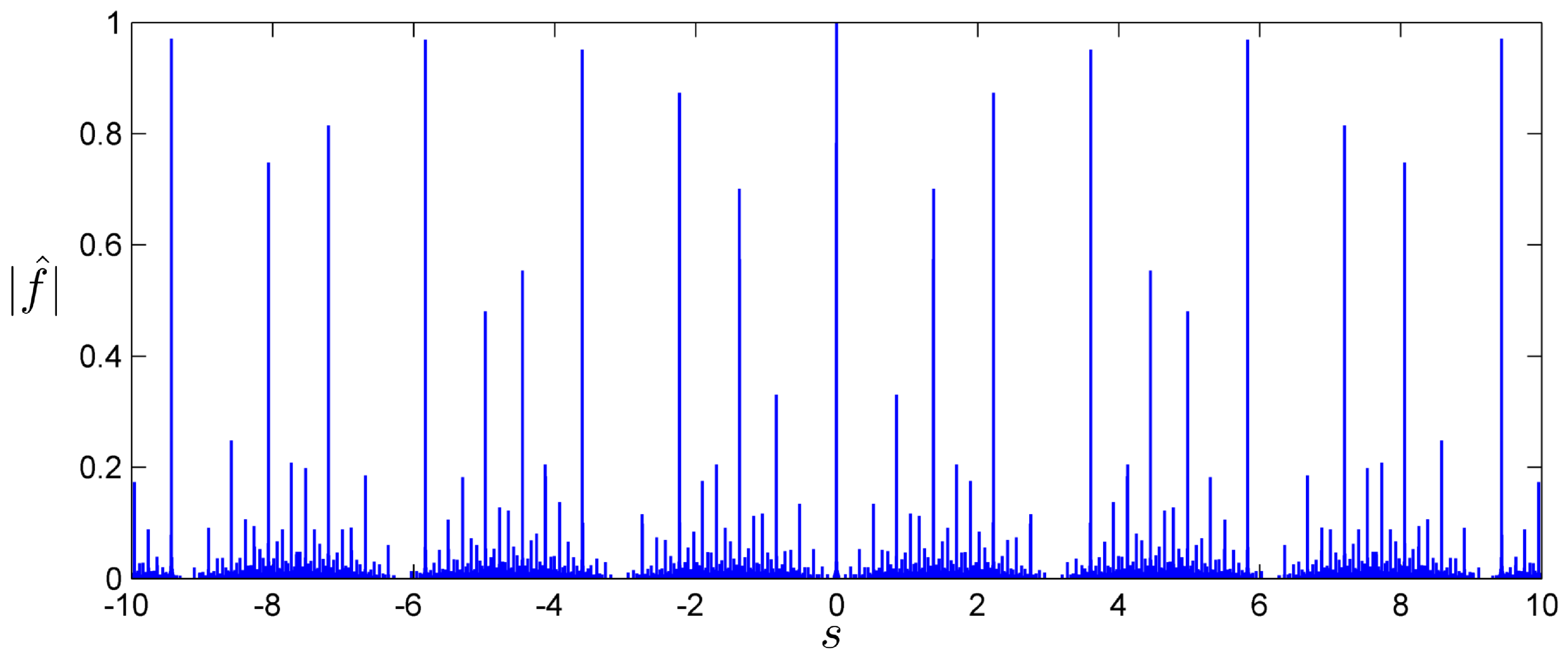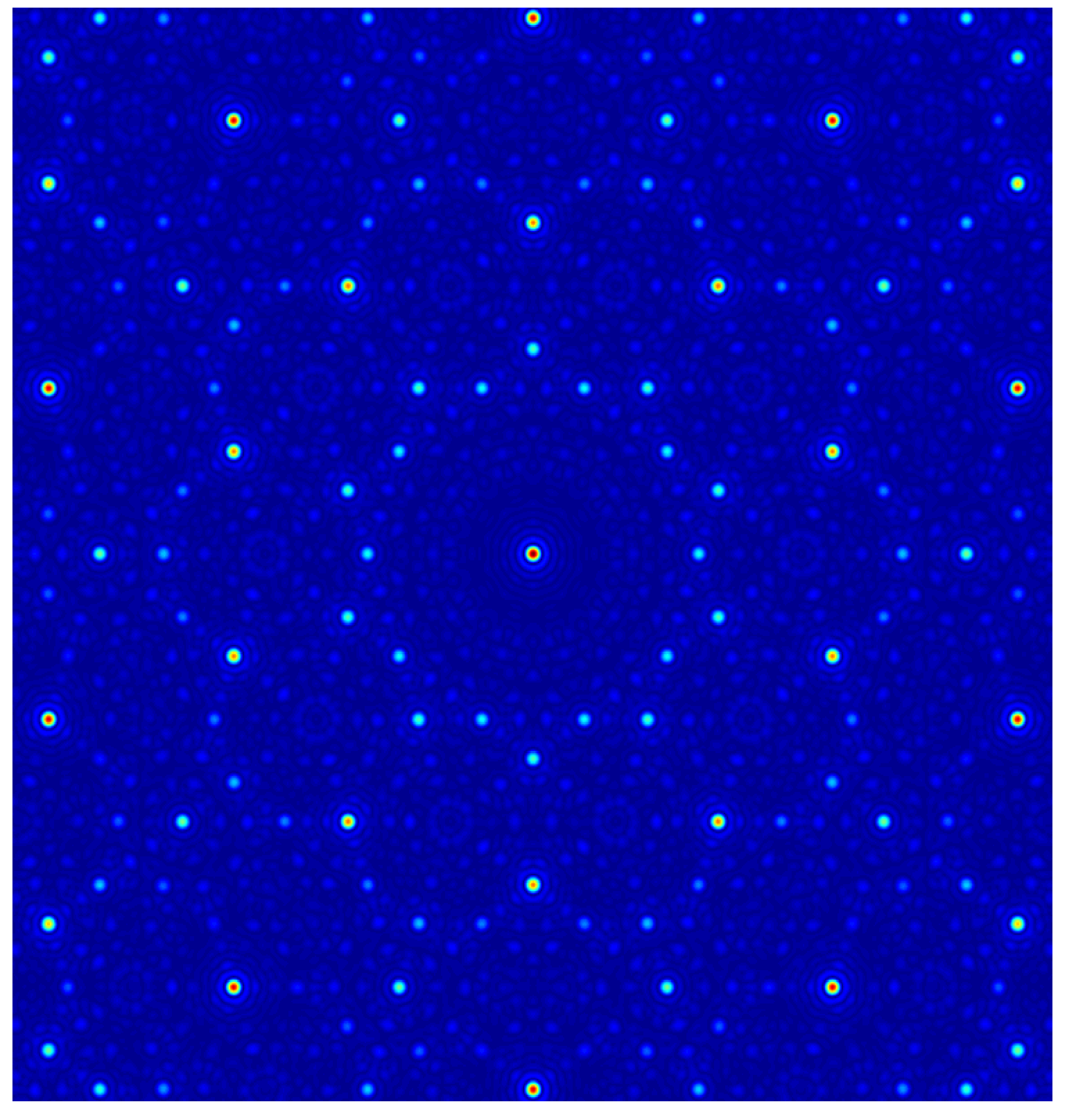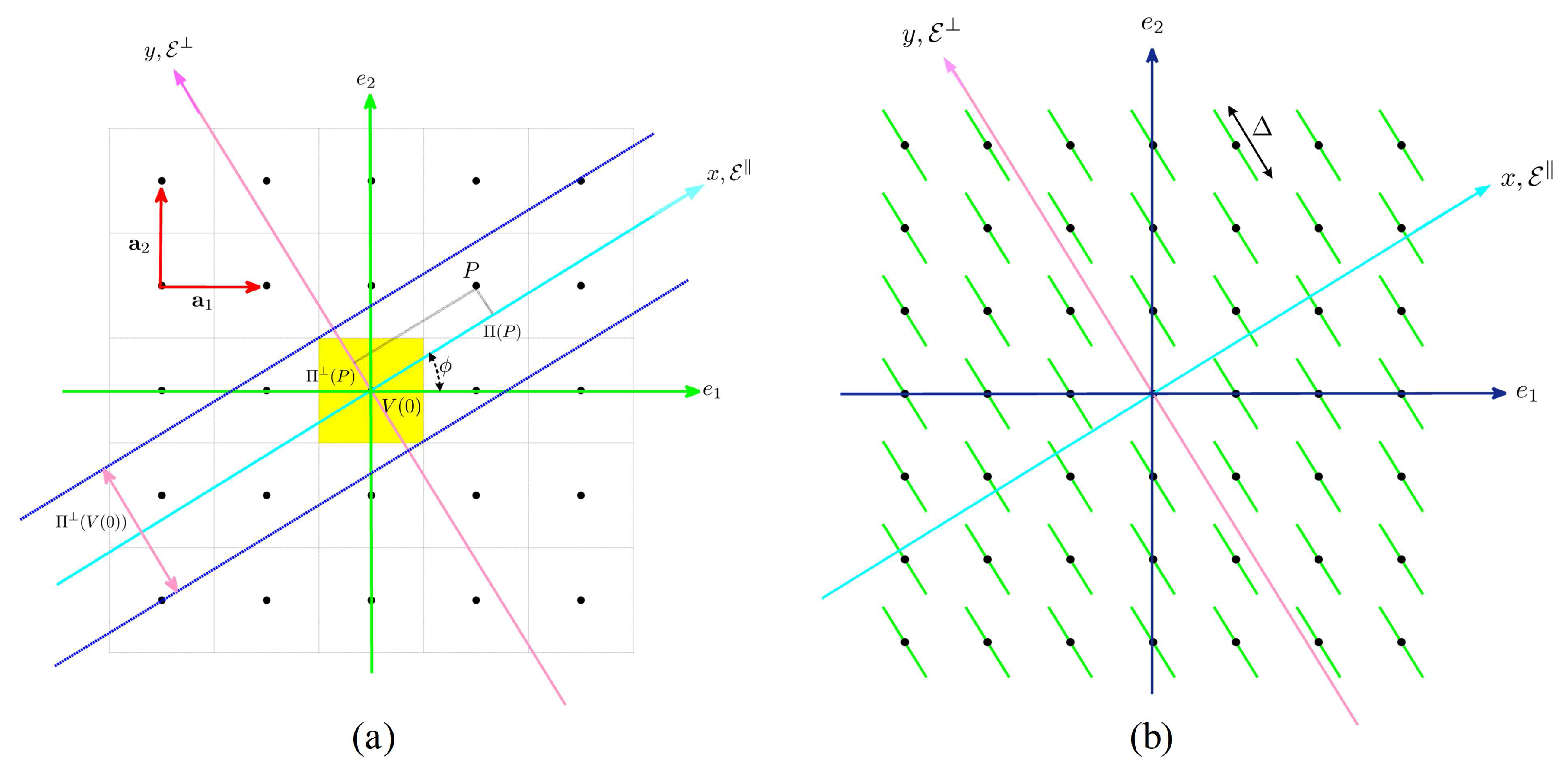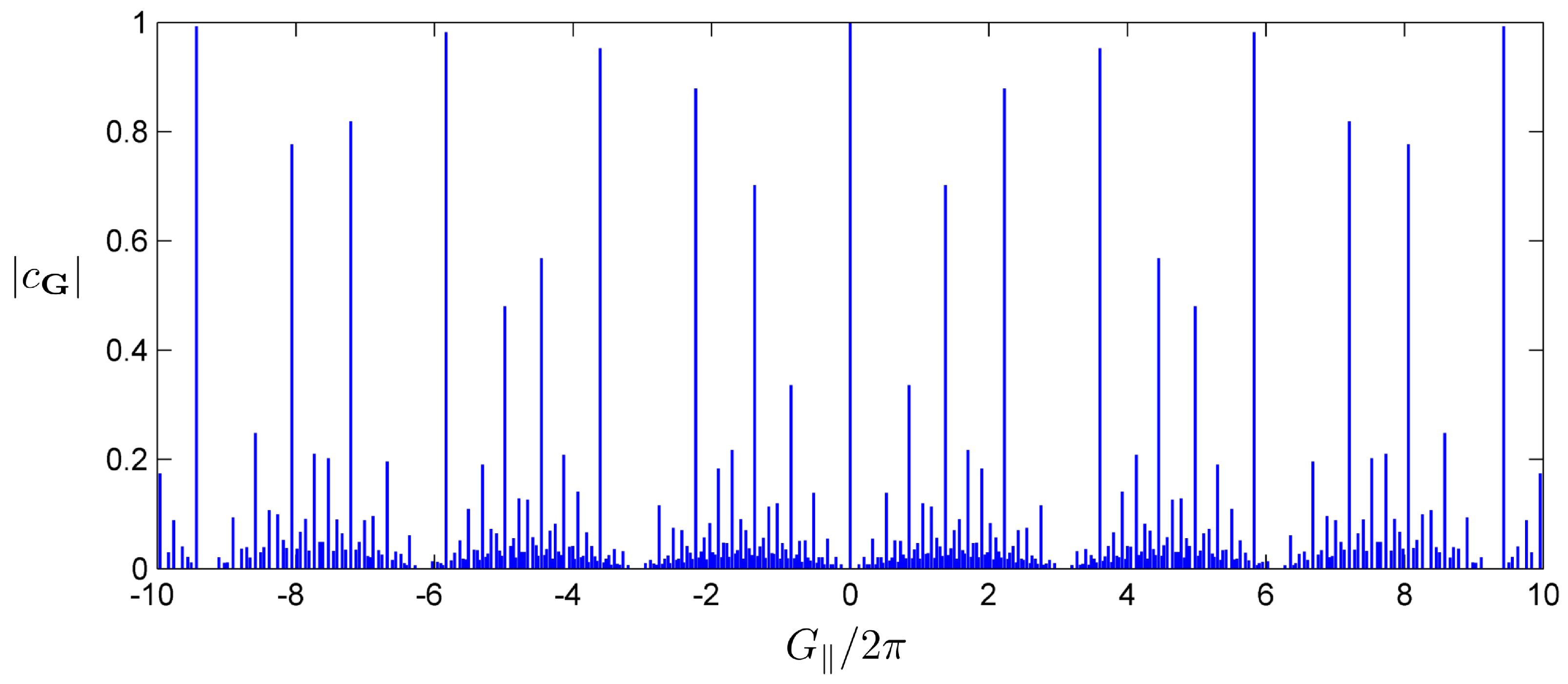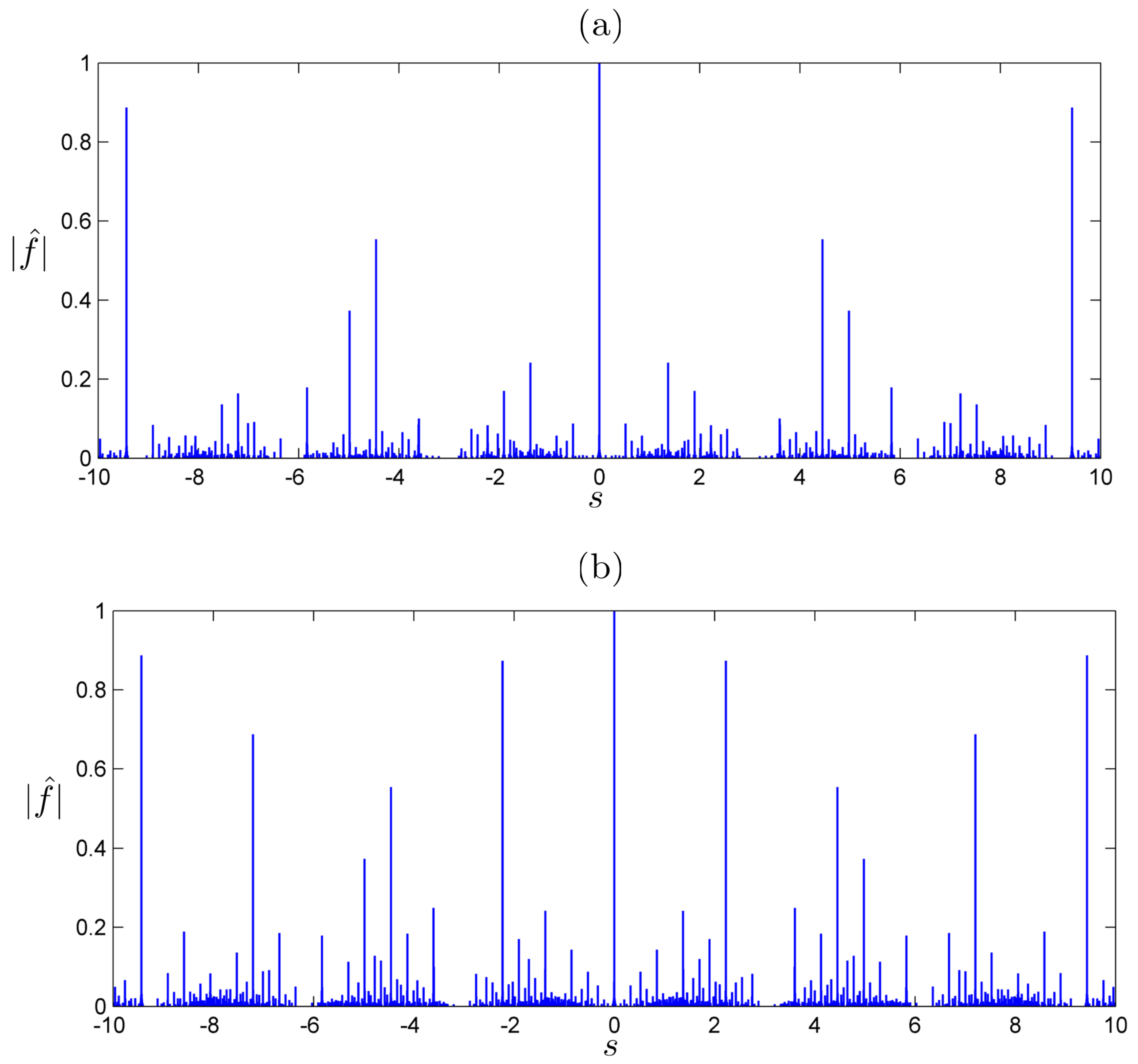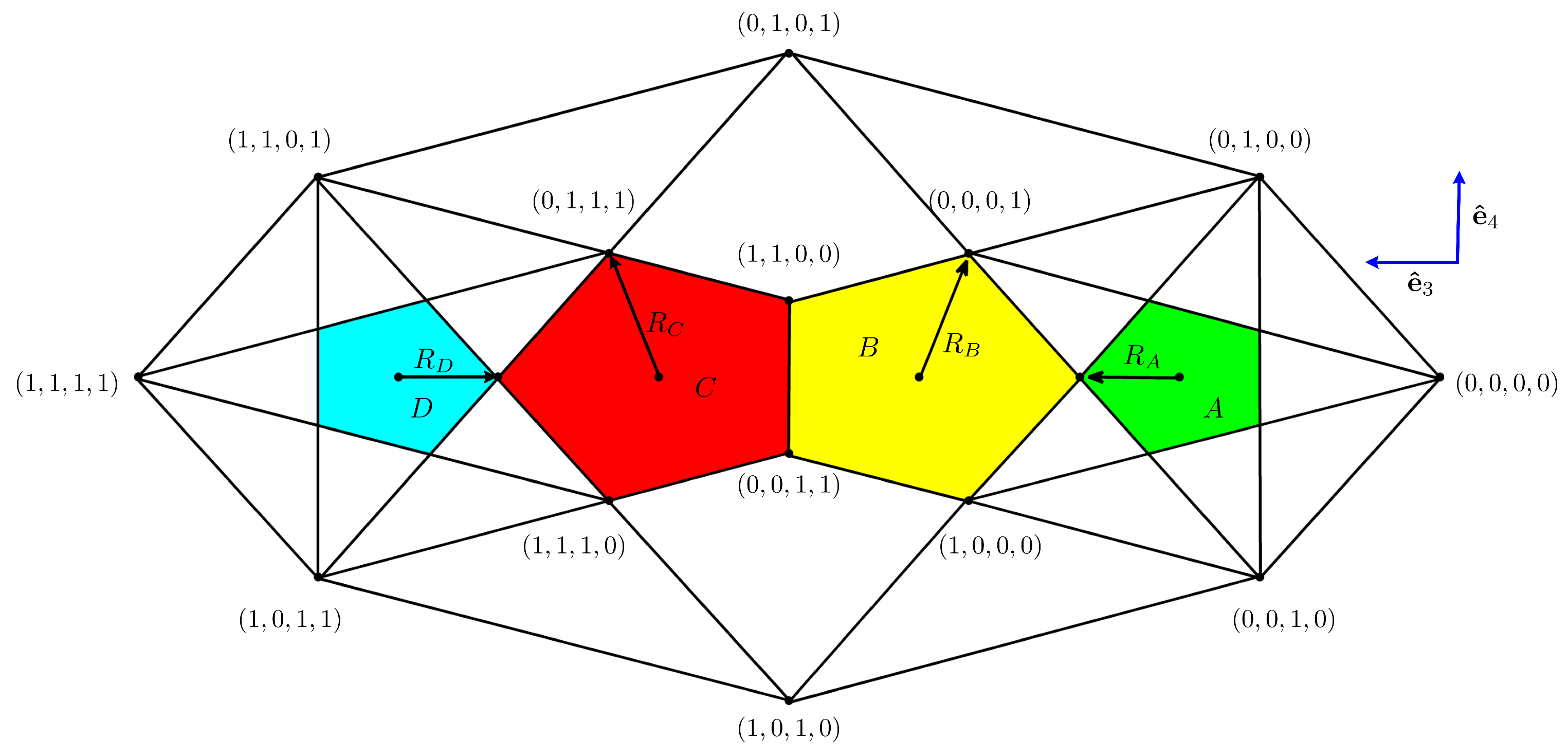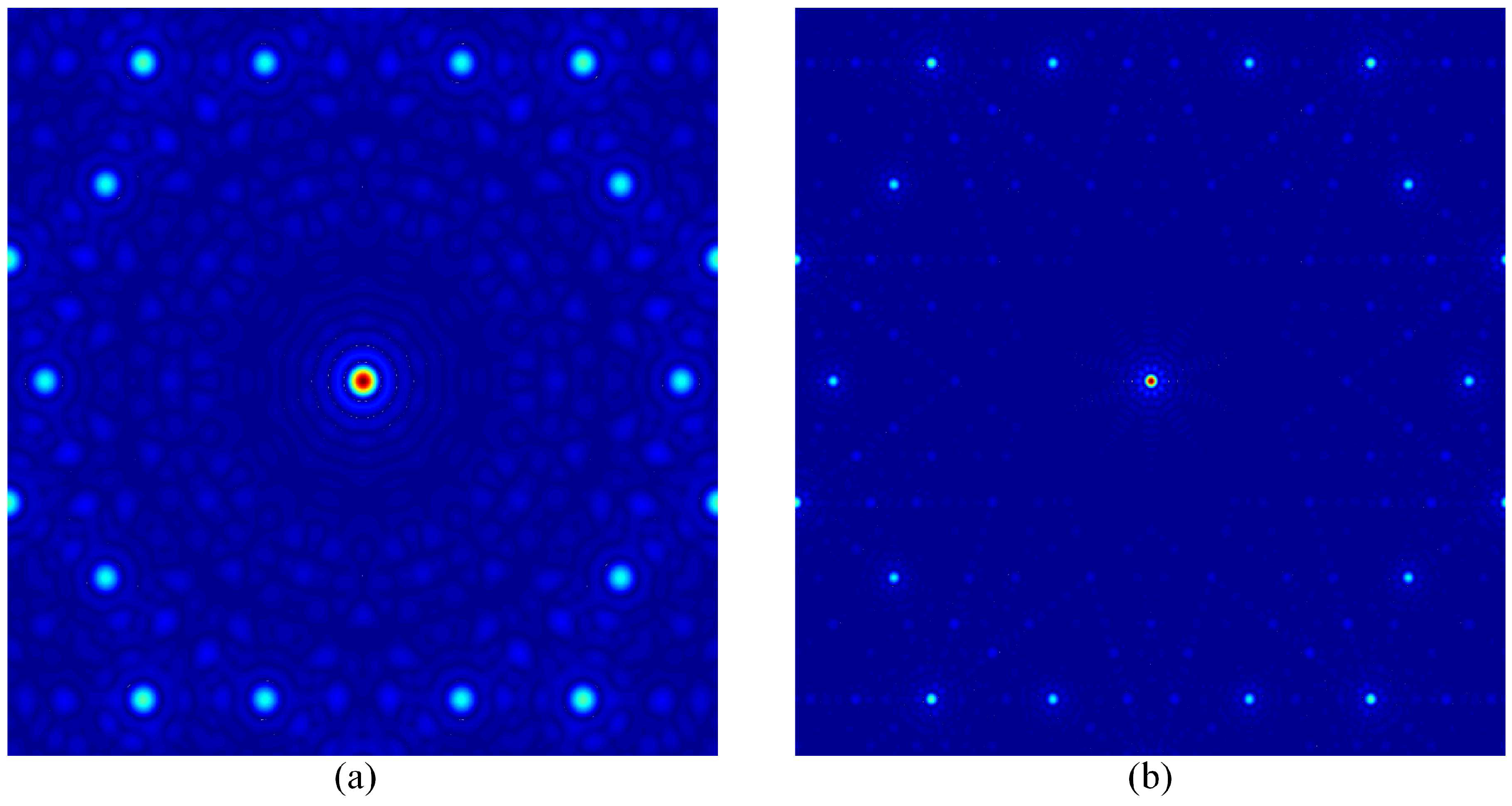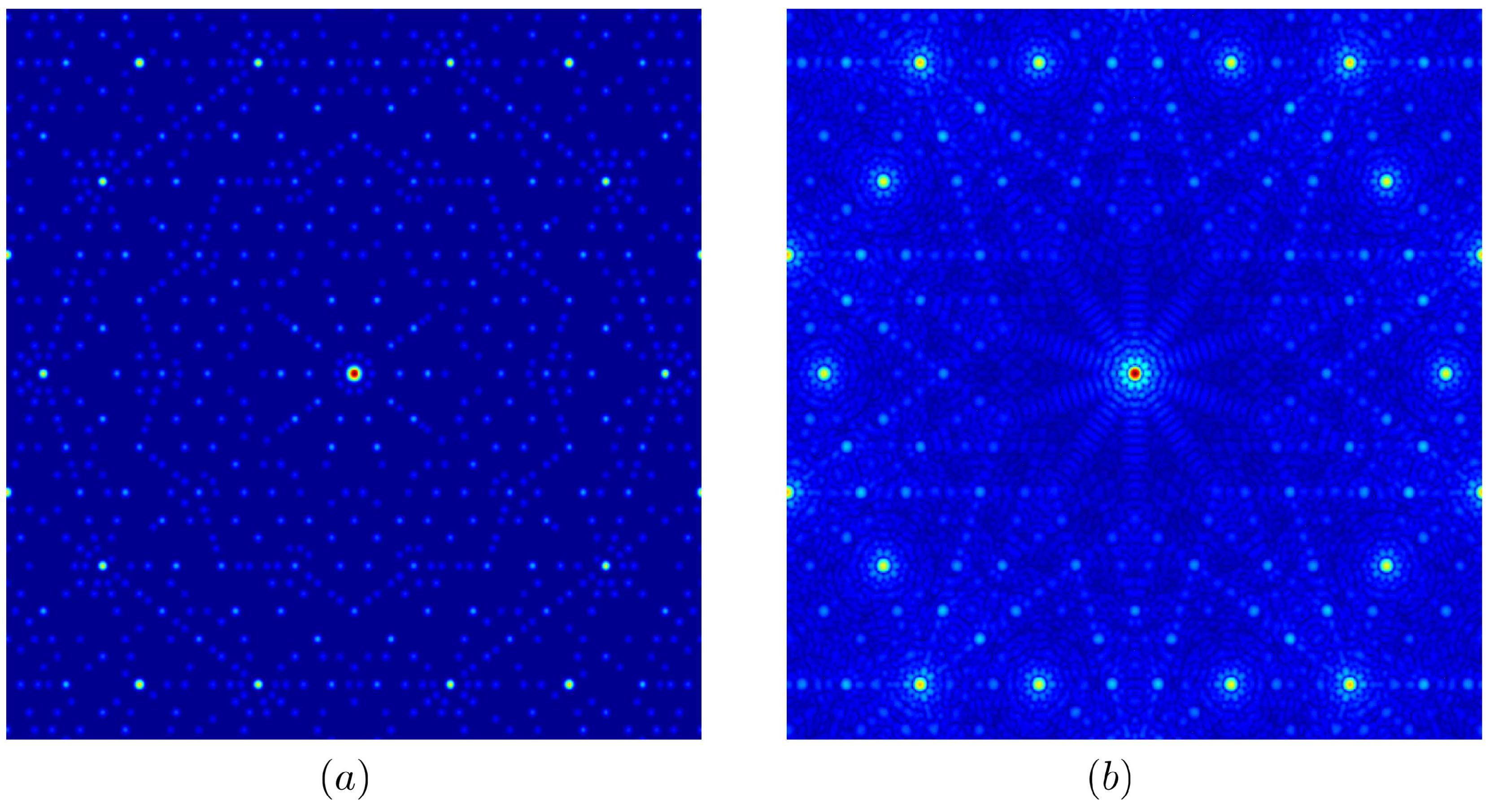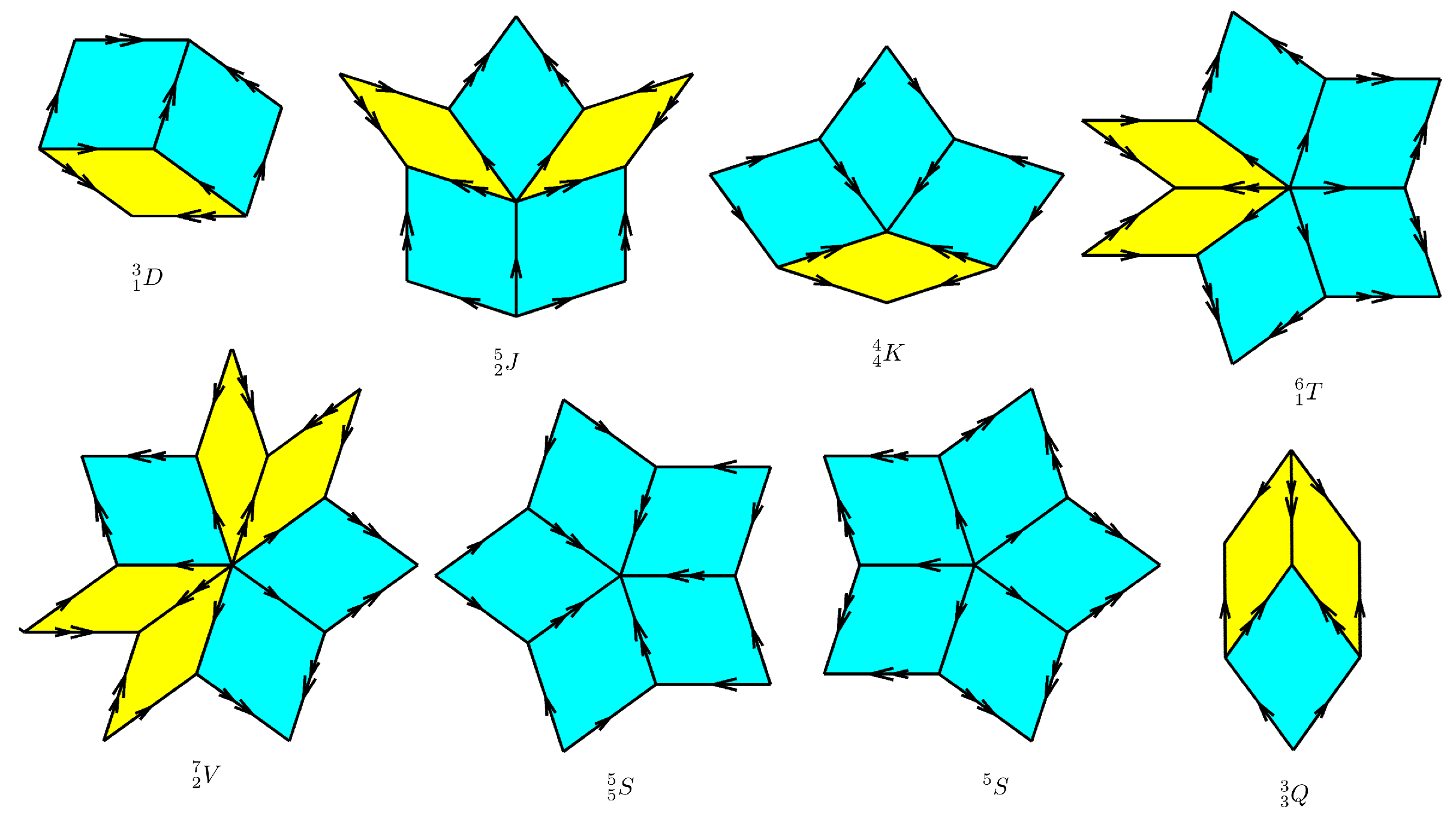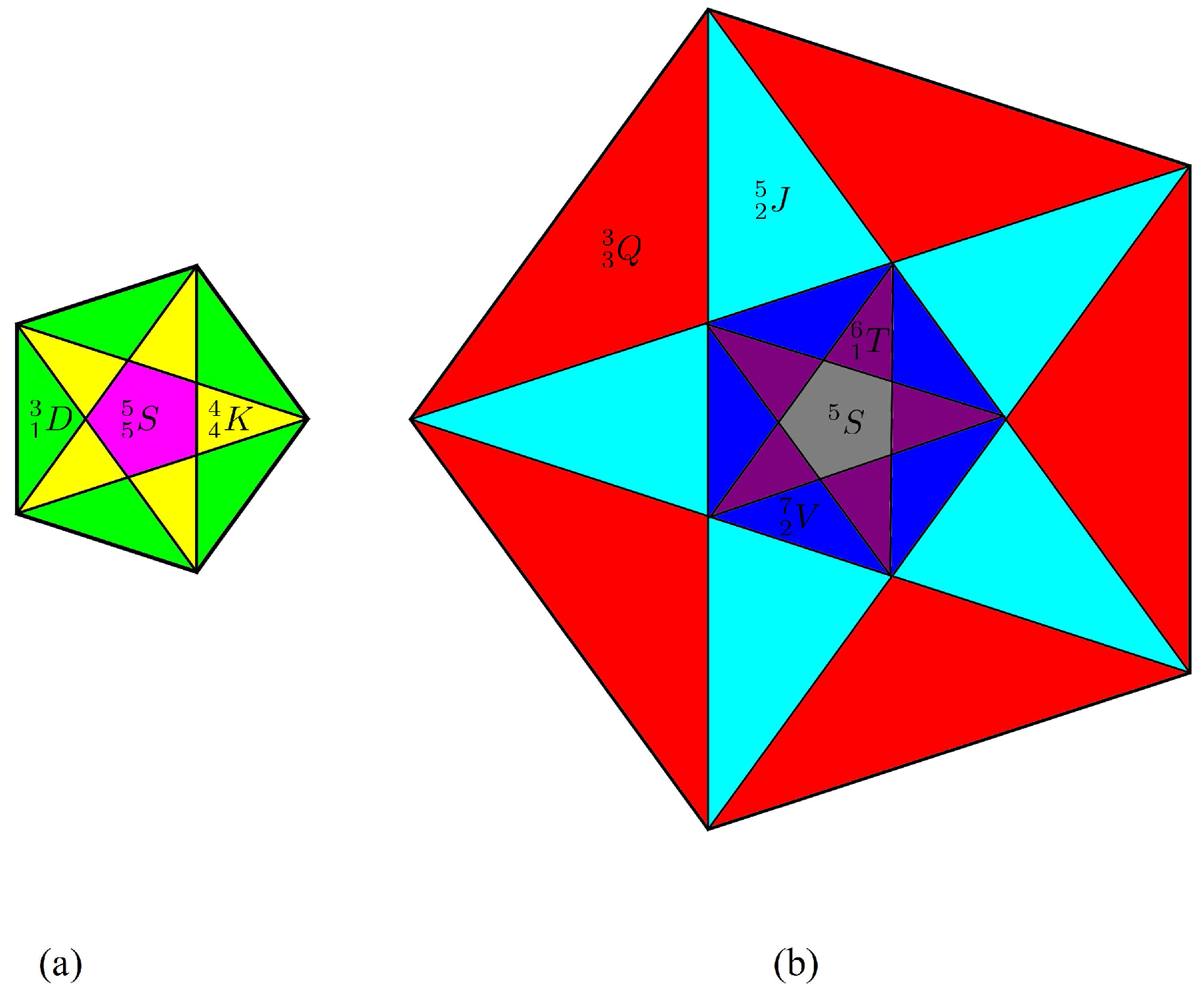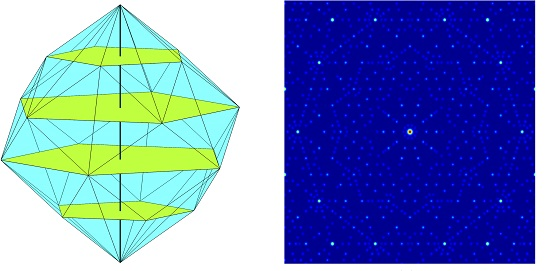4.1. Fibonacci QC
The Fibonacci QC lattice can be obtained using the cut-and-project method by taking a 1D irrational slice of a 2D periodic lattice [
1], such as that shown in
Figure 4a. The primitive lattice vectors are unit vectors along
and
denoted respectively by
and
, as shown in
Figure 4a, where without loss of generality, we have assumed that the lattice constant is unity. As a result, every lattice point can be represented by a set of integers. This is referred to as an integer lattice and denoted by
, where the subscript 2 corresponds to the dimensionality of the lattice. The Voronoï cell at the origin is highlighted and denoted by
.
We start by defining a new orthonormal basis with unit vectors
and
directed along
x and
y, as shown in
Figure 4a. As can be seen, the unit vectors
and
are obtained by rotating the unit vectors
and
by an angle
φ, where
. It can easily be shown that the transformation from the
basis to the
basis can be obtained by the unitary mapping
:
where
. Using this mapping, the subspace
x is referred to as the parallel or external subspace and is denoted by
. The parallel subspace corresponds to the physical space. Subspace
y is referred to as the perpendicular or internal subspace and is denoted by
. The perpendicular subspace corresponds to the unphysical space. As shown in
Figure 4a, for every lattice point,
P, its projection onto the parallel subspace
is denoted by
, and its projection onto the perpendicular subspace
is denoted by
. A Fibonacci lattice can now be obtained by the projection of lattice points onto the parallel subspace
. However, not all lattice points are projected onto the parallel subspace, and a selection criterion is used to determine the set of lattice points that should be projected to obtain a Fibonacci QC lattice. The selection window is shown in
Figure 4a as the region between two parallel lines above and below the
x-axis. This region corresponds to lattice points who’s orthogonal projection onto the perpendicular subspace, denoted by
, falls inside the perpendicular projection of the Voronoï cell at the origin, which is denoted by
in
Figure 4a.
An alternative way to generate QC lattices using the cut-and-project method is by decorating the lattice points with an atomic surface (AS) [
18,
27]. ASs are projections of the higher dimensional unit cell onto the perpendicular subspace. The points of intersection of the decorated hyper-lattice with the parallel subspace yield the QC lattice.
Figure 4b shows the decorated hyper-lattice for the Fibonacci QC. The ASs are line segments of length
.
Since the decorated hyper-lattice is periodic with lattice vectors
and
, it can be expanded in terms of a FS:
where the sum is over all RVs
defined as:
such that
and
are the primitive RVs, which are related to lattice vectors
and
by
where
is the Kronecker delta function and
is the position vector. It is customary to use an equal number of terms for each dimension, which we denote by
N, leading to a total number of
terms in the FS. The value of the Fourier expansion coefficient
in Equation (4) is given by:
where the integration is performed over the area of a unit cell. It is more convenient to evaluate the integral in Equation (6) in the
basis using a change of variables:
where
is the AS in the
basis and can be expressed as
. Using this expression, we arrive at the following result for
:
Equation (8) gives the value of the Fourier harmonic
for the RVs
as defined in Equation (5). The RVs are defined with respect to the lattice vectors
and
. We can also express the RVs in terms of the parallel and perpendicular subspaces as
where
is the projection of
onto the parallel subspace and
is the projection of
onto the perpendicular subspace. Thus, for the RVs
as defined in Equation (5),
and
are:
As it was noted earlier, the parallel subspace corresponds to the physical space. Hence, in the same manner that the 1D QC lattice was obtained by taking a slice of the decorated hyper-lattice along the parallel subspace, we can obtain the diffraction pattern of the QC by taking a slice of the reciprocal space of the hyper-lattice. Thus, only the parallel components of the RVs and their corresponding Fourier harmonics are considered.
Figure 5 shows the normalized diffraction pattern of the Fibonacci QC using this method. A FS expansion with 441 terms
has been applied to the hyper-lattice ASs, and the resulting Fourier harmonics have been plotted versus the parallel components of the RVs. The results shown in
Figure 5 can be verified by comparing them to
Figure 1, which obtained the diffraction pattern by taking the FT of a very large super-cell structure.
Figure 1 was obtained by evaluating the FT of a 2585 lattice at 100,001 points in the reciprocal space. As was noted, when taking the FT of a very large, but finite point lattice, it is critically important to use a very high resolution in sampling the reciprocal space, since otherwise, some strong peaks might be missed. This point is demonstrated in
Figure 6. Both
Figure 6a and
Figure 6b correspond to the FT (magnitude) spectra of the 2585 Fibonacci lattice, which was considered previously. The only difference is that in
Figure 6a, the reciprocal space has been sampled at 10,001 points, and in
Figure 6b, it has been sampled at 20,001 points. As can be seen, both of these patterns lack many of the peaks shown
Figure 1, which was sampled at 100,001 points.
4.2. Penrose QC
Using the cut-and-project method, the Penrose QC lattice can be obtained as a 2D slice of a 5D periodic hyper-lattice. Obtaining the Penrose QC as a 2D slice of the 5D space is known as the canonical projection, which means that the unit cell of the hyper-lattice is a 5D hyper-cube. Using this method, the hyper-cube points are mapped onto a 2D parallel space and a 3D perpendicular space. However, as was noted previously, the minimum dimension of the embedding space for a QC with
k-fold rotational symmetry is
, where
is Euler’s totient function and
. Since lower dimensionality reduces the computational burden of the problem, we use the minimal space embedding to obtain our results. An important distinction between the 5D embedding and the 4D embedding is that in the case of the 4D embedding, the hyper-lattice is non-orthogonal. The 4D non-orthogonal hyper-lattice is known as the
root lattice, and the 4D unit cell is a hyper-rhombohedral [
20]. A complete discussion of the derivation of the 4D lattice is given in [
18,
21]. Here, we only state the results, which are important for this work. We consider the 4D Euclidean space with the standard orthonormal Euclidean basis
. The primitive lattice vectors for the
root lattice are given by:
where
and
. The parallel subspace
is the plane spanned by
, and the perpendicular subspace
is the plane spanned by
. The AS consists of four pentagons in the perpendicular subspace
, which we denote by
and
D. The
and
D of the AS are respectively centered at points
and
, where
is the body diagonal of the unit cell. The mapping matrix
from the lattice basis to the Euclidean basis is:
Figure 7 shows the projection of the hyper-rhombohedral unit cell onto the perpendicular space
. Each vertex is denoted by its coordinate in the
basis. The four ASs have been highlighted and the perpendicular space basis vectors
and
have been shown for reference. The radii of the pentagons are [
18]:
Taking a 2D slice along the parallel space of the 4D hyper-lattice will generate a Penrose QC lattice, where the tile side is
[
18].
At this point, it is desired to obtain the FS expansion of our higher dimensional unit cell. To accomplish this goal, the periodic AS can be expanded in terms of Fourier harmonics:
where the sum is over all RVs
defined as:
and
is the 4D position vector given by:
As before, for practical reasons, the infinite expansion is truncated to the finite set of RVs defined as:
which leads to a total of
terms. The value of the Fourier harmonic coefficient
in Equation (4) can be determined from:
where the integration is performed over the 4D
root lattice. The term
corresponds to the volume of the unit cell, which due to non-orthogonality, is not unity and must be accounted for. It is more convenient to evaluate the integral in Equation (17) in the
basis. Applying a change of variables to Equation (17), we arrive at:
where
is the AS in the
basis. As shown in
Figure 7, the AS surface of the 4D hyper-lattice consists of four pentagons, which lie in the perpendicular space
. The centers for ASs
and
D in the
basis, respectively, are
and
, where
. The AS of the 4D hyper-lattice can be represented as the sum of four pentagonal ASs, as shown in
Figure 7. The linearity property of the FS expansion can be exploited to evaluate the expansion for each ASs separately. Evaluating individual FS terms requires performing double integration over the area of a pentagon. While this could be performed numerically, we were able to derive analytical expressions, which improved the calculation time by almost three orders of magnitude. The derivations for the analytical results are included in the
Appendix. Using these results, we can now evaluate the Fourier harmonic coefficient
for each RV
in closed-form. However, as was done in the case of the Fibonacci QC, we only need to consider the parallel component of each RV, which corresponds to the physical space. For RV
as defined in Equation (14), the parallel space component, denoted by
, is a 2D vector in the
plane given by:
such that the first element of the
corresponds to projection along
and the second element corresponds to projection along
, where at this point, we can associate
and
with the Cartesian dimensions of the physical space.
As noted earlier, a QC possess a discrete diffraction pattern.
Figure 8a shows the magnitude of the normalized FT of a Penrose lattice with 731 points obtained from a Penrose tiling with prototile sides of
. Moreover, this prototile side corresponds to the lattice obtained by taking a 2D slice of the 4D hyper-lattice. As can be seen from
Figure 8a, while there are several bright spots in the pattern, the pattern is not truly discrete, since there are ripples surrounding the bright spots. This is due to the finite size of the super-cell lattice.
Figure 8b shows the magnitude of the normalized FT of a Penrose lattice with 1961 points. Compared to
Figure 8a, the diffraction pattern in
Figure 8b displays a much better discrete nature. However, while increasing the size of the super-lattice increases the accuracy of the diffraction pattern, it will also require much finer sampling in the reciprocal space since the diffraction peaks will become more delta-like with a very narrow width. Thus, a very fine sampling of the reciprocal space is required to capture all of the diffraction spots, which further increases the computational burden of the problem. The diffraction pattern in
Figure 8b was obtained by sampling 3001 points along each dimension of the reciprocal space for a total of roughly nine million points.
Figure 9 shows the normalized diffraction pattern of the Penrose QC obtained from the FS expansion of the 4D hyper-lattice with 279,841 terms
. Here, we note some important details regarding
Figure 9. First, due to the very large number Fourier harmonics, we have performed a thresholding and only plotted Fourier harmonics above a certain threshold. We have used the threshold of
dB in
Figure 9. Secondly, since it is extremely difficult to discern delta-like peaks in the diffraction pattern due to their infinitesimal width, to better visualize the discrete peaks, we have used Gaussian pulses of the form
, where
A is the amplitude of the Fourier harmonic expansion coefficient,
R is the Euclidean distance from the location of the Fourier harmonic in the reciprocal space and
α is some arbitrary positive decay constant.
Comparing
Figure 8b with
Figure 9, we can see that many of their features are identical. Both figures have been normalized, and as a result, it is difficult to discern peaks with a smaller magnitude. To overcome this issue, instead of plotting the normalized magnitude of the diffraction peaks, we plot the square root of the normalized magnitude. This non-linear mapping has the effect of enhancing smaller peaks, which allows for a better comparison of finer details. This comparison is illustrated in
Figure 10. The square root of the normalized FS expansion harmonics obtained from the expansion of the ASs in the 4D hyper-lattice are displayed in
Figure 10a, while
Figure 10b plots the square root of the normalized FT of a Penrose super-lattice. As can be seen, these plots display many of the finer features not visible in
Figure 8b and
Figure 9. One of the most striking features seen in
Figure 10a, which is not present in
Figure 10b, is the discrete nature of the diffraction pattern. This phenomenon is particularly noticeable in the region surrounding the origin, where in
Figure 10a, a series of discrete peaks are present, whereas in
Figure 10b, a series of ripples surround the origin. The presence of ripples surrounding the bright spots in FT patterns can lead to inaccurate results in several ways. First, they can mask weaker diffraction peaks, as can be seen in
Figure 10b, in the region surrounding the origin. Moreover, they also can lead to the appearance of spurious spots in the pattern (in-phase addition).

